

by Rachel Smith
21 July 2023
It’s exciting to finally bring you the pay rates survey results 2023! We’ve split the results into two blog posts (part 2 is next week) and we’ll be using the data to update our pay rates report as well. We want to make it a bit more comprehensive and useful, given the freelancers in the Rachel’s List orbit have so many varied talents. So stay tuned. It’s a-coming!
We had 270 people answer the survey this time and we got heaps of comments from many of you – so thanks so much for sharing your experiences when taking on freelance work and gettin’ paid.
A large part of the survey involved asking freelance-related questions, and how you handle common finance-related issues such as pricing, finding work, or scope creep. So we’re going to start with those, and bring you the nitty gritty on actual pay rates next week.
Here’s what you had to say on these topics.
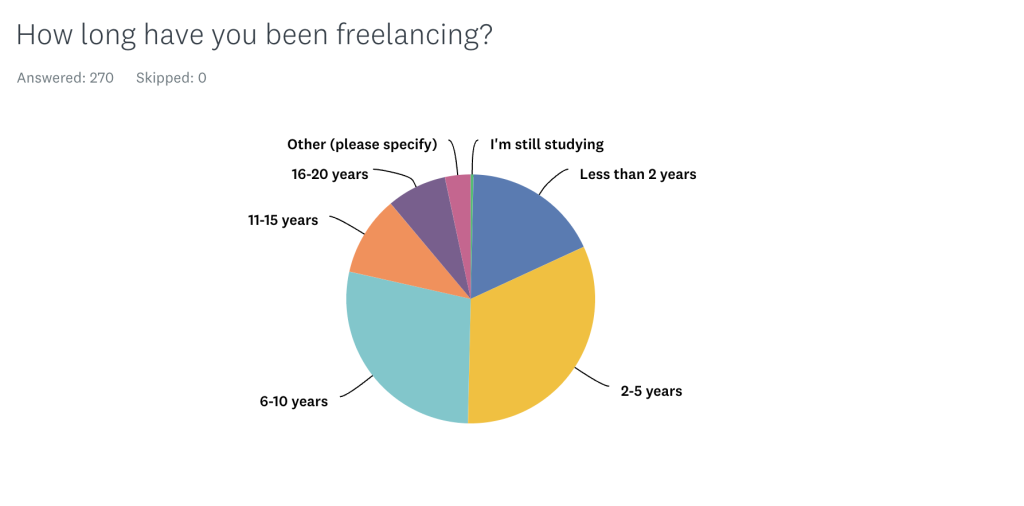
Interesting to see that the majority of freelancers answering the survey haven’t been at this whole freelancing thing for that long – but we know freelancing can be quite a fluid career and people dip in and out, so this might reflect a ‘new’ stint of freelancing in between perm work. Some of you elaborated more in the comments:
“I’ve freelanced on and off for 18 years and still have permanent part-time jobs, but also freelanced and still do, in between having kids.” Said another, “I’ve freelanced on and off (more on than off) for the past 20 years.”
It’s always interesting to see the types of writers who answer our survey and this time, it was skewed heavily towards copywriters, journalists and writers – not surprising, as those are the three main groups Rachel’s Listers fall into.
However, we also had book editors, comms specialists, content producers and strategists, digital marketers, designers, grant writers, podcast producers, PRs, sub-editors and teachers all share their thoughts, too.
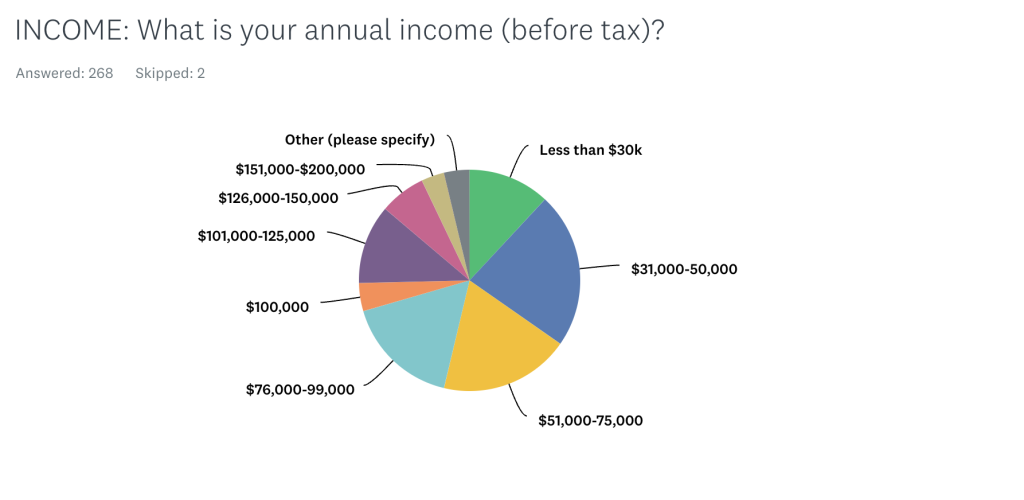
Some interesting results here. Quite a lot of respondents (22.7 percent) are earning under the $50k mark, but 19 percent nominated their annual earnings as $51-75k and a further 17 percent nominated $76-99k. In the higher echelons, a combined 22 percent were earning between $100-200k.
We dove into the comments to see what you had to say.
For some people, it looks like freelancing is just a part of their income and not the whole pie. “I do less than 20 hours per week by choice and no more than 40 weeks per year, as I’m working on a book for the rest of the time,” said one respondent.
Another wrote, “I’m just starting out and slowly building my client base.”
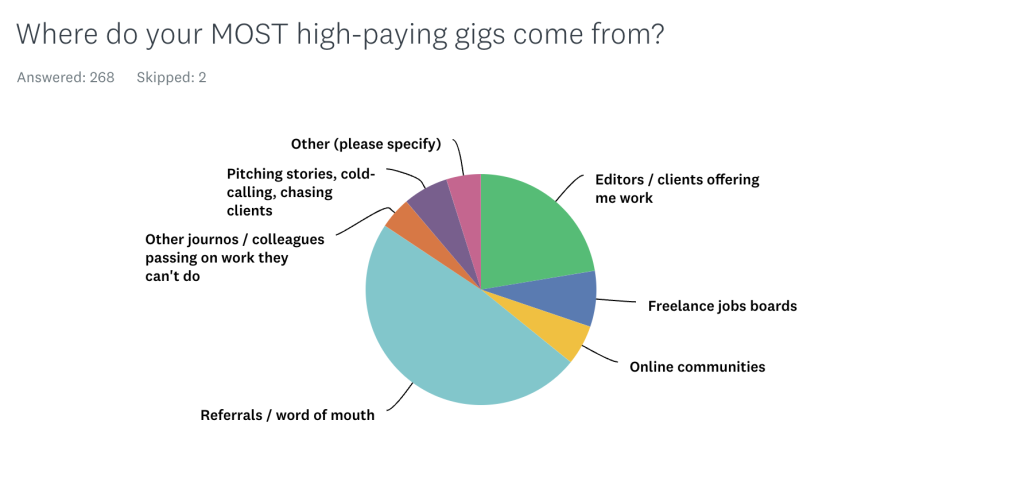
We weren’t surprised to see that the most high-paying gigs come from referrals and word of mouth. We saw similar data from a recent survey conducted by Jennifer Goforth Gregory (one of our Summit keynote speakers) – and also, in our recent webinar with Jennifer and Ed Gandia, she spoke about how the writers she polled are overwhelmingly picking up work from existing clients and referrals from other writers. Check out more highlights from that here.
In another question on how you find work – any work – the two biggest pieces of the pie were referrals, and editors / clients coming to you with projects. This was followed by a pretty even split between jobs boards and online groups and communities. Pitching / cold-calling didn’t rate as highly.
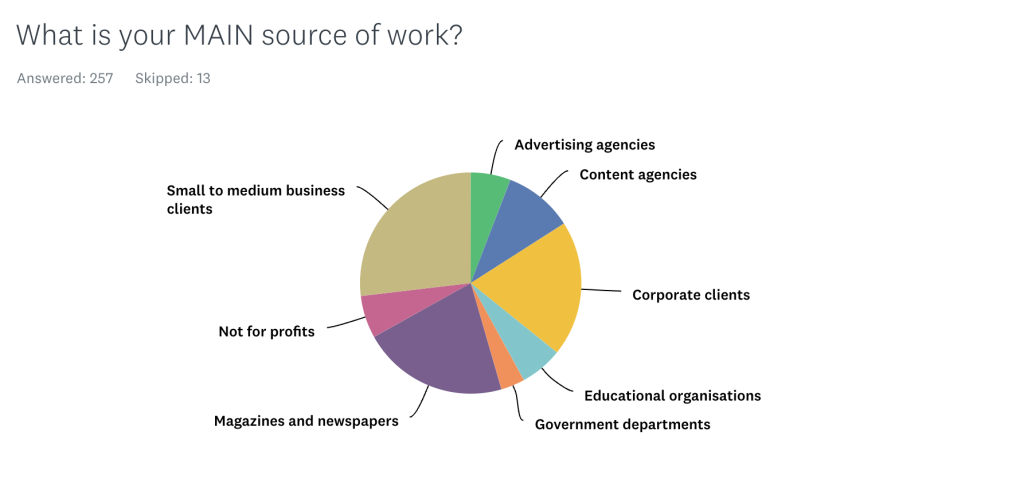
The majority of you get most of your work from three main places – small to medium businesses (27 percent), followed by corporates (20 percent) and magazines and newspapers (21.4 percent). The next most common avenues for work were content agencies, non profits, educational organisations, ad agencies and govt departments.
In the comments, you threw a few more possibilities in the mix: “My main source of work is an online subscription-only newsletter.” Others nominated “research institutes”, “start-ups” and “authors and academics”.
A huge question and it’s good to see so many people doing a range of different projects. According to the survey results, the most common types of products you’re taking on include blog posts, copywriting, content writing, journalism, website copy and social media.
Less common: brochure writing, case studies, content market and strategy, corporate comms, email marketing and newsletters, ghost-writing, landing pages, opinion pieces, press releases, subbing and training/ teaching.
The more niche areas were clearly white papers, UX writing, product descriptions, ghost-writing, ad writing, book editing and grant writing. Some of you definitely do these things, but they’re not top of the list.
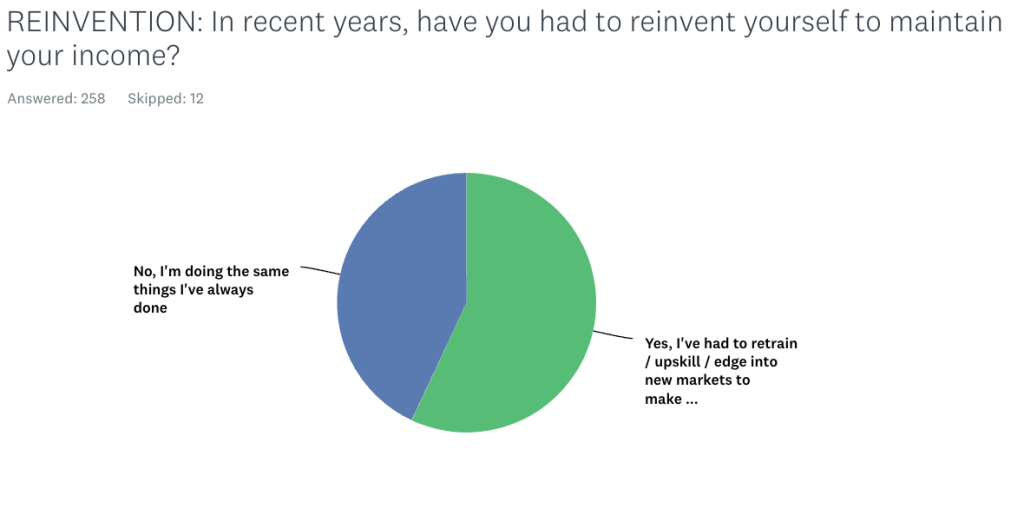
The last time we did the survey and asked this question, 52 percent said they’d dived into new markets and upskilled in order to make a living. This time, 57 percent said they’d reinvented themselves – which is obviously reflective of freelancers needing to evolve in our ever-changing industry!
The things you’re all choosing to learn is super varied too – we had sponsored content to video editing, public speaking to policy writing. Marketing, SEO, learning Facebook or Google Ads, AI tools, digital marketing all got a mention.
From the comments: “I’ve transitioned from bread-and-butter journalism to more of a strategic content role, working on CRM, website relaunches, brand campaigns, PR and all facets of branded comms – I really enjoy the mix of projects and clients which still draws heavily on my editorial background, but is more stable and well-paid.”
Another respondent said, “I’ve pivoted towards digital publishing, SEO and content strategy.” And a third added “scripting for corporate videos and podcasting”.
Many have left journalism behind altogether: “I moved from journalistic work into UX writing, content design and teaching.”
Some of you simply switched to better-paying niches: “I used to work mainly on health and homes magazines but work was drying up, so I moved into personal finance and business so I could attract corporate clients who pay more generally.”
There was a spectrum of comments about the general upheaval in the industry too, and the need to keep learning: “I think constant learning and professional development is essential for this industry; for any industry really,” said one. But not everyone felt this: “I’ve just had to pivot, pivot, pivot until i don’t know what’s up anymore. It’s been exhausting.”
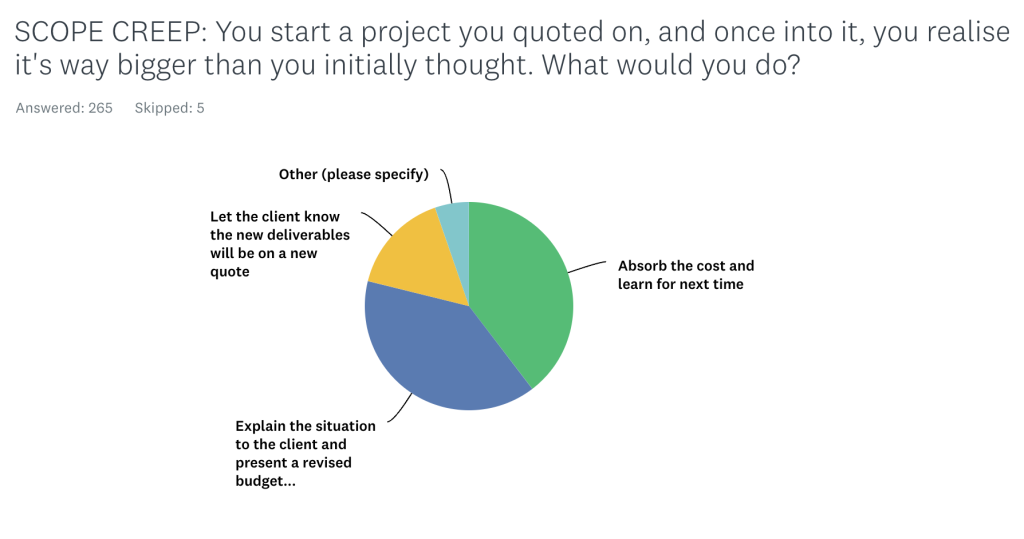
Scope creep is a big problem for freelancers and this was an eye-opener, with a pretty even split between the freelancer absorbing the cost versus presenting a revised budget to the client. The comments showed just how many of you handle scope creep on a case-by-case basis.
Said one respondent: “Depends on the client, the job, the extent of the creep, and the degree of hassle involved in not just absorbing it. Sometimes it’s a blend of the two – ask client for extra but not the full amount. And it depends too on who’s responsible for the scope creep: are they sneaking more in, or did I just stuff up the maths when I quoted?”
Said another: “If the work is different to what was briefed, that’s on the client. If I misunderstood the brief or didn’t ask the right questions before quoting, that’s usually on me and I’ll wear it.”
And a third: “Depends on how much I want to retain the client – whether I absorb the cost or re-quote the new deliverables.”
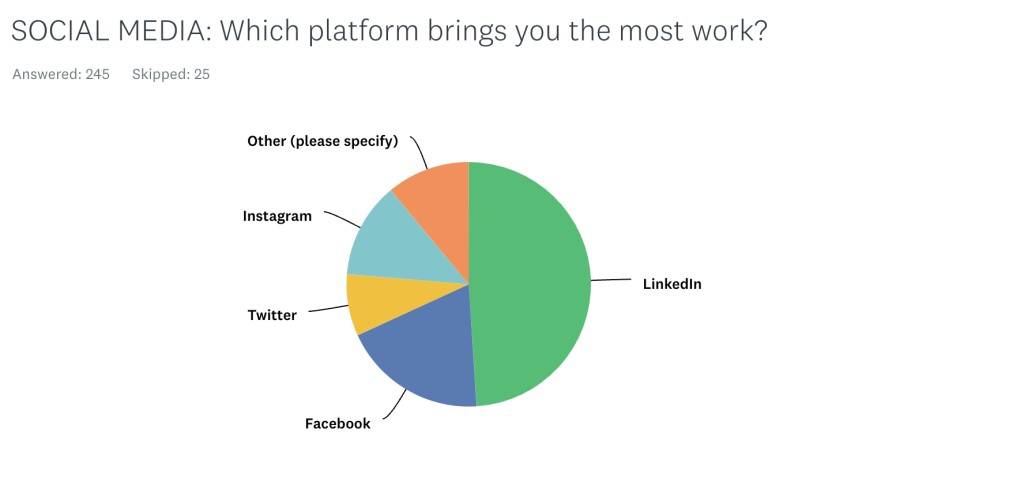
As this pie chart clearly indicates, if there was ever a time to start learning how to leverage LinkedIn, now is it.
Being visible on the platform, being helpful, engaging with other people, commenting on posts… all of that is important when it comes to growing your profile. But it’s also the best research space around for snapping up new writing / content clients. Apply for the LinkedIn for Journalists Program to get a premium account, make lists of leads and find the content managers who’d be most likely to be hire you. Send LOIs, follow, repeat. It’s a numbers game but it can definitely serve up some lucrative work.
That said, there were a fair few comments from those of you who said social had never brought you any work. And a couple commented that FB groups were the only way: “Facebook, only because of the closed groups I’m in. A networking group and a copywriting group bring referrals and projects. I don’t do any advertising and not much posting on Facebook.”
We offer overflow work postings in our FB group for Gold members and I know many other groups that do too – so I agree being in the right groups (particularly on FB) can be a really effective way to pick up new clients.
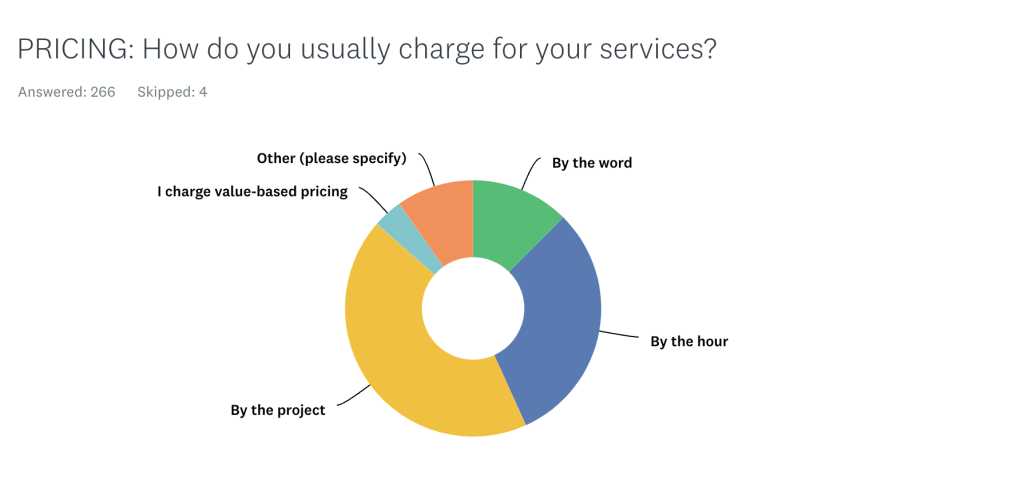
I think these results are a reflection of far more copywriters answering the survey than in recent years – as word rates are generally reserved for publishing. Many of the journalists in our community have moved into content and copywriting (often mixing these two with journalism), and would be used to working by the hour or by the project.
Less popular pricing methods are value-based pricing, which can be a more complex pricing method – one that you might consider if you’re working on projects with high profit margins and know the business and industry well.
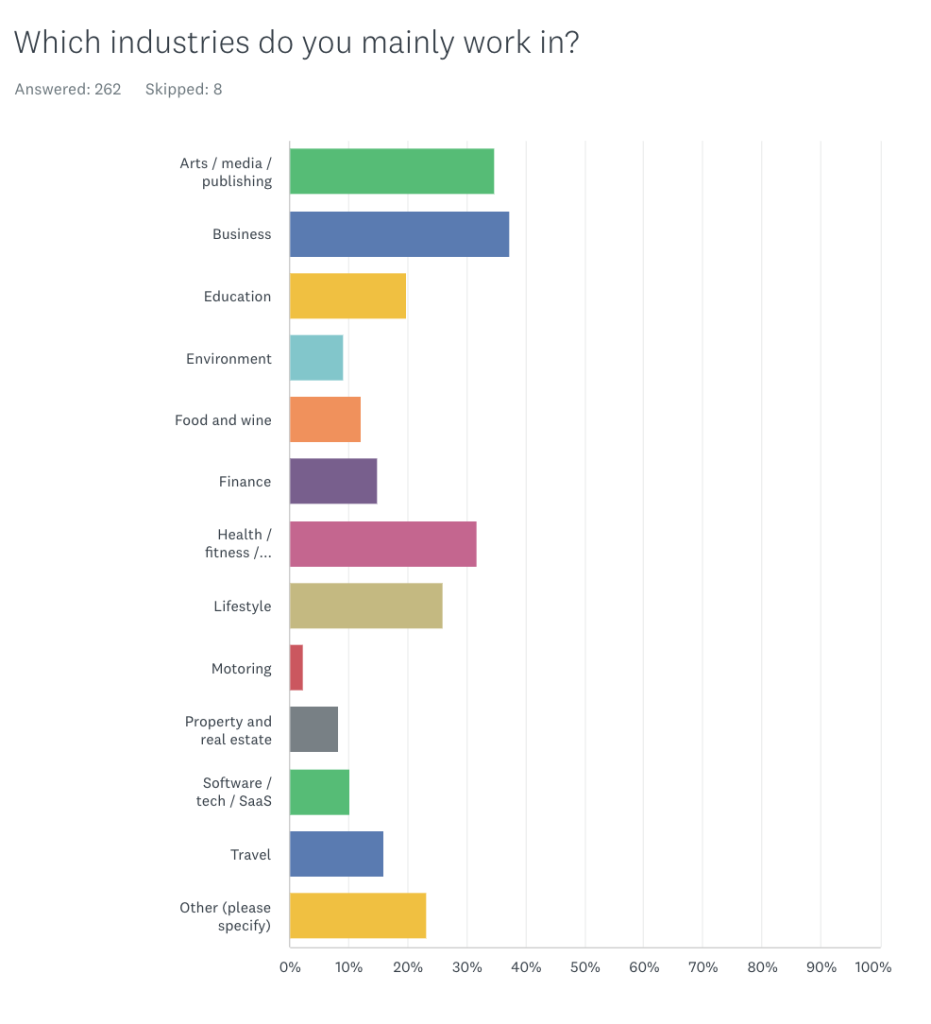
Health, lifestyle and business featured a lot in this breakdown, but we had a LOT of comments for this one too. ‘Where is the science journalism box?!’ one person asked. (Sorry about that, we struggled big time to fit in as many as we did!)
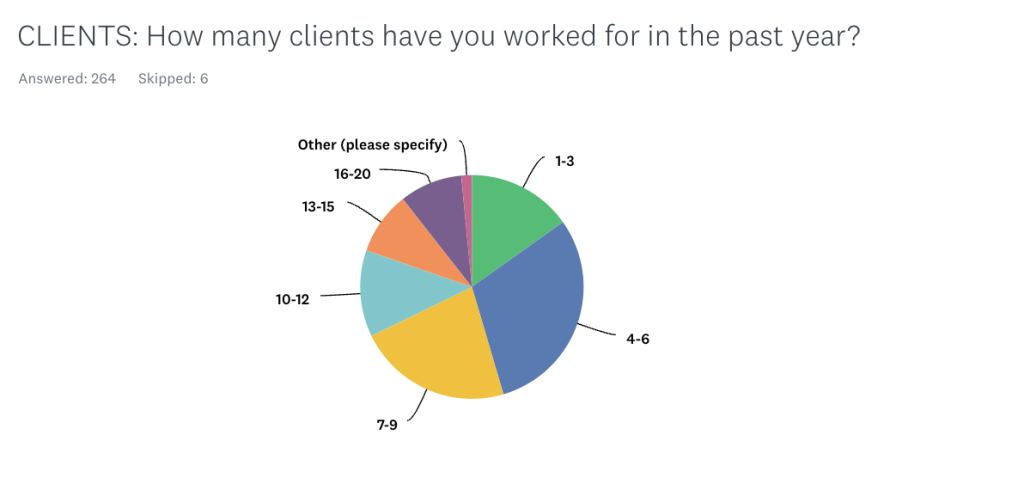
I was quite interested to see that 30.3 percent worked for 4-6 clients in the past year. RL’s biz manager / wing-woman Claire (who also works for other freelance clients besides us) said it reflects her client base too. “I thought I was unusual,” she said when we were discussing these results. “It tells me how important relationship building is for freelancers, and creating longevity with those anchor clients.”
Totally agree. In the comments though, a few people had worked for over 20 clients in the past year – and one person said they’d worked for 50+ clients which sounds bloody exhausting!
What are your thoughts about the pay rates survey results 2023? We’d love to hear! Look out for part 2 next week when we delve into what you get paid for various projects and types of work.